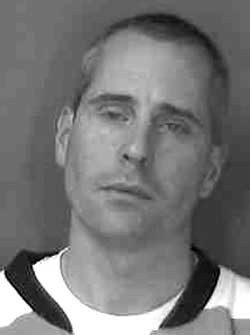News travels fast and often doesn’t hold the public interest for very long. That’s one reason to go through the ritual of recalling what happened in 2011. Remember Dr. Hsiao?
The other reason to do so is because the stories you read in these pages — and our blog, Blurt — don’t end when the reporter files them. They continue to evolve, sometimes taking turns that are more interesting than whatever made us pursue them in the first place.
With that in mind, our news writers followed up on some of the most compelling stories of the year, from the spring floods in Burlington to Occupy Lowell Mountain. Of course, that led us to the well-trod wake of Tropical Storm Irene. No other story this year packed as much punch or led our print and video journalists down so many fascinating tributaries.
Death-With-Dignity Bill Never Had a Chance... (Jan. 12)

Hans Penner
File photo by Matthew Thorsen
Backers of a right-to-die law had high hopes at the start of the 2011 legislative session. Newly elected Gov. Peter Shumlin pledged support for “death with dignity” legislation during the 2010 campaign and had cosponsored a right-to-die bill as a state senator the year before. The Death With Dignity National Center targeted Vermont as the most likely state for a legislative victory in 2011 and helped launch a local grassroots campaign through Patient Choices Vermont. The bill would have given terminally ill patients with fewer than six months to live the option to request a fatal dose of medicine. Hans Penner of Shelburne, a 76-year-old retiree with inoperable stage IV lung cancer, thought it sounded like a good idea. “I’m a good Darwinian. I understand that’s a natural thing,” Penner said of death back in January. “If that’s what it came to, my hope is the legislature would have passed that bill.” Doctors and religious groups opposing the bill warned that “physician assisted suicide” was a slippery slope the state should not start down.
Update: Two right-to-die bills attracted large numbers of cosponsors — 44 in the House, 11 in the Senate — but neither got a hearing in committee. House Speaker Shap Smith said he wouldn’t bring it up because it didn’t have enough votes to pass, and Senate President Pro Tem John Campbell, a devout Catholic, opposed the legislation.
The same politics — and same leaders — will greet right-to-die supporters in 2012, but Patient Choices Vermont hasn’t given up hope. It’s collecting video testimonials from high-profile pols, such as former governor Madeleine Kunin, as well as from average Vermonters who support the legislation.
As for Penner, PCV lobbyist Amy Shollenberger reports he is “in pretty bad shape. He is getting radiation, and his voice is almost totally gone. He’s just not feeling well at all.”
—A.B.
*****
PBG vs. BTV: Despite Turbulence, the Rivalry Continues (Feb. 9)

Plattsburgh International Airport
File photo courtesy of Kevin J. Kelley
By expanding service, lowering fares and upgrading its facility, Plattsburgh International Airport appeared to be positioning itself as an alternative to Burlington’s beleaguered BTV. Cheapo Florida flights from PBG, which calls itself “Montréal’s U.S. Airport,” had propelled a surge in passenger traffic, with Canadian and North Country fliers also attracted by three direct flights a day to Boston on Pinnacle Airlines. A few PBG customers interviewed in February said they would have flown from BTV had the same prices and destinations been available.
Update: PBG is experiencing turbulence that could delay its arrival as a competitive threat to BTV. Plattsburgh airport manager Tom Long resigned suddenly in September for unexplained personal reasons. That same month, Pinnacle Airlines announced it would sever the link between PBG and Boston’s Logan airport.
Long’s replacement, Christopher Kreig, who’s been on the job just two weeks, spins both developments as no big deal. Operations at PBG, including an expansion of its terminal, are proceeding smoothly, he says. “We’re growing as projected,” Kreig declares.
Pinnacle, flying as US Airways Express, will account for only about 10,000 of PBG’s 130,000 anticipated departures this year, Kreig says. What’s more, the terms of the federal subsidy Pinnacle receives for serving PBG stipulate that it can’t stop flying to Boston until a replacement carrier is found for that route. Kreig acknowledges, though, that a Pinnacle successor might charge more than the $178 PBG-Logan round-trip fare listed for mid-January.
The Florida flights, priced as low as $177 round trip in January, remain a huge draw, Kreig adds. Canadians account for 90 percent of PBG’s departing passengers, and their numbers have doubled in the past three years.
In contrast, BTV has experienced a slight decrease in passengers. It reports 430,000 year-to-date “enplanements,” down from 434,000 for the same period in 2010 — a 0.9 percent decrease.
— K.J.K.
******
Have Audiences Accepted Vermont’s New Ticket Tax? (March 16)
In 2010, the Vermont legislature passed a law requiring nonprofit arts presenters to collect a 6 percent sales tax on ticket purchases. Some presenters said the law, which went into effect on April 1, was the last thing they needed. Lyric Theatre and Champlain Valley Exposition officials warned that the extra fees could dissuade less-affluent Vermont families from buying seats for their shows, especially in a bad economy. Taking note of the recession, Flynn Center CEO John Killacky suggested: “To introduce a 6 percent sales tax at this moment just isn’t right.”
Update: The legislature softened the projected impact by passing an amendment exempting nonprofits that register less than $100,000 in ticket sales annually. The law had originally set a $50,000 threshold. Consequently, only about a dozen nonprofits have to charge the tax, notes Vermont Arts Council executive director Alex Aldrich. He estimates that the tax will generate about $250,000 in new annual revenues for the state rather than the anticipated $700,000.
Lyric Theatre CEO Syndi Zook says she can’t tell if the tax affected sales for the troupe’s recent production of Hairspray. But she does know that the extra charge has caused “exasperation” among Lyric patrons and staffers. Additional bookkeeping obligations have “cost us staff time, which is another burden for a shoestring nonprofit.”
Killacky says it’s not clear if the tax, which amounts to 7 percent in Burlington, represents a tipping point in an economy that hasn’t improved. He has heard complaints about the tax — but acknowledges that they’ve come primarily from people who bought tickets anyway.
Just before Christmas, the Flynn received a $1 million gift from an anonymous donor that will be used to replace the theater’s 1453 seats.
— K.J.K.
*****
Documenting Opiate Addiction in St. Albans (May 4)

Katie Tanner and Fred Holmes
File photo by Matthew Thorsen
Fred Holmes had been a pediatrician in St. Albans for 34 years when a patient he’d known since birth revealed he needed help with a prescription-drug addiction. At the time, 2006, Holmes had no idea what the 18-year-old was talking about. The local doc is now an expert on the subject. Since then, his practice, Mousetrap Pediatrics, has received more than 4000 calls from Vermonters seeking help to get their kids, or themselves, off drugs. Today, one-third of Holmes’ patients are in recovery from opiate abuse. Holmes is the only pediatrician in the state prescribing Suboxone, a drug that can be very effective in weaning addicts off legal opiates such as OxyContin, Vicodin and Percocet. Many patients credit Holmes, and Suboxone, with saving their lives. But Suboxone is also controversial. It’s now the No. 1 abused drug in Vermont prisons, and many doctors want nothing to do with it.
Update: Holmes plans to retire next summer, and, so far, no other pediatrician has come forward to replace him as the go-to doctor for treating teen opiate addiction with Suboxone. Meanwhile, the 67-year-old doctor will feature prominently in a documentary on the subject. After making movies about foster children and heroin addiction in Vermont, filmmaker Bess O’Brien is training her camera on opiate abuse in St. Albans.
O’Brien has enlisted help from David Sheff, author of the No. 1 New York Times best seller Beautiful Boy, about his own son’s drug addiction. Sheff is scheduled to visit St. Albans in April to participate in community meetings related to the film project.
O’Brien, says Holmes, “seems to be everywhere, and this adventure alone has generated a great deal more chatter about our young folks and the messes they seem to get themselves into.” The doctor isn’t about to just walk away. He’s working with the HowardCenter and the Vermont Chronic Care Initiative to finalize a “multidisciplinary team approach to help the youngsters.”
— K.P.
*****
After the Floods: Is Lake Champlain More Polluted? (May 18)

Homes in the Champlain Islands
File photo by Matthew Thorsen
There was a lot of competition in Vermont this year for Most Calamitous Weather Event. Before Tropical Storm Irene, the projected “winner” was the spring flooding that damaged hundreds of homes on Lake Champlain. Scientists speculated the May inundation could have long-lasting repercussions for the lake’s already-troubled ecosystem. One scientist in particular expressed concern about the “huge phosphorus load” flushed into the lake. There was fear of unprecedented algae eruptions that would be deadly to fish and hazardous to boaters and swimmers. But there were also suggestions of positive outcomes in the form of a carp population explosion and lots of construction work.
Update: Eric Smeltzer, the state scientist who monitors lake pollution, says follow-up studies show that on one day in April, twice as much phosphorus poured into the lake from the Winooski River than the amount contributed by 60 water treatment plants on the Vermont side of the lake over a six-month period. Larger-than-normal algae blooms did occur last summer, confirms Mike Winslow, staff scientist for the Lake Champlain Committee.
But neither Smeltzer nor Winslow can specify the effects on the lake’s health. No one has any idea, for example, whether carp copulation did produce a baby boom. Both monitors say ongoing studies will yield definitive data, but Smeltzer points out, “The lake certainly can recover from such an event.”
Much will depend on how humans respond, he adds. If homeowners “armor” — for example, by building a retaining wall — their lakefront property that could damage shoreline biohabitats, Smeltzer warns.
Contractors did experience an increase in business, says Amanda Ibey of the Home Builders and Remodelers Association of Northern Vermont. She can’t quantify the windfall, but notes that flooding repairs “helped a lot of people come out of the dark period when there was no work.”
— K.J.K.
*****
The Jury’s Still Out on the Reliability of Vermont’s Breath Testers (April 6, May 18)

Last April, two state chemists blew the whistle on problems in Vermont’s breath-testing program. In written statements entered in the course of a routine drunk-driving case, chemists Darcy Richardson and Amanda Bolduc claimed that the lab technician responsible for maintaining and certifying the breath-test devices used by Vermont police had employed questionable methods over a period of years. They said lab supervisors did nothing to correct it. Criminal defense attorney David Sleigh used the claims to argue that results from the breath testers were unreliable and therefore inadmissible in court. Health department officials insisted the instruments were reliable, even as a malfunctioning breath tester in South Royalton led prosecutors to dismiss and plea bargain dozens of DUI cases in Windsor and Orange counties.
Update: Gov. Peter Shumlin responded to the scandal by ordering that the breath-testing program be moved from the Department of Health to the Department of Public Safety. The latter has a fully accredited laboratory. That change is scheduled to take place in March 2012.
Meanwhile, the fundamental question of whether the DataMaster DMT breath testers are reliable remains unanswered. Sleigh’s law office, which started out with six drunk-driving defendants questioning the instruments, now has more than 50 challenges pending in three counties. An evidentiary hearing set on January 20 in Caledonia County will determine whether any or all of those cases can proceed. Sleigh filed the first of the motions in June. “It’s a ridiculous amount of time,” Sleigh says of the delay.
— A.B.
*****
Fogel Falls, but Won't Say Farewell to UVM (May 25)
In February, University of Vermont President Daniel Fogel announced his resignation, effective July 2012. His plans changed as a result of a Seven Days investigation, which exposed a sexually charged relationship between his wife, Rachel Kahn-Fogel, and a top UVM fundraiser. The paper’s investigation prompted an internal campus probe, the findings of which were made public in August. By then, Fogel had stepped down from his post ahead of schedule, assisted by a very golden parachute that promises to pay him more than $30,000 a month through the end of 2012. Fogel also received a $195,000-a-year faculty appointment in the English department — over $85,000 more than the next-highest-paid prof — with the expectation that he’d begin teaching in January 2013. Fogel’s severance package, and his “build it and they will come” legacy, prompted much debate on campus about the affordability and future of the state’s only public university. UVM trustees named former provost John Bramley as interim president and began a search for a permanent, full-time prez.
Update: In October, UVM trustees adopted a new presidential-spouse policy that puts stricter oversight on husbands and wives who want to raise money, coordinate alumni events or engage in other aspects of university life. Their volunteer work must be approved by the board and not include any supervisory authority.
The UVM Presidential Search Committee recently spent a few days in Boston interviewing 12 candidates for the top job on campus. A list of finalists will be made public in early 2012.
Meanwhile, former president Fogel dispelled rumors that he might forgo the teaching gig due to the bad vibes caused by his departure. He told Seven Days he’s been assigned to teach classes on English Romantic poetry and Henry James next fall. A James scholar, Fogel is working on a new biography about the famous American author.
“I am currently directing an honors thesis with a UVM undergraduate,” wrote Fogel in an email, “and am greatly looking forward to returning to teaching at UVM in the next academic year.”
— S.T.
*****
Accounting Questions Percolate at Green Mountain Coffee (June 15)

Sam E. Antar
Waterbury-based Green Mountain Coffee Roasters began 2011 under a cloud of suspicion: an ongoing investigation of its accounting practices by the U.S. Securities and Exchange Commission. But investors hardly seemed to care. As the months ticked by, the value of the company’s stock climbed steadily, from $34.45 a share on January 3 to $82.54 a share on May 27. But one bean counter smelled trouble. Sam E. Antar, the accountant who cooked the books at appliance chain Crazy Eddie in the 1980s, claimed he had discovered numerous accounting “irregularities” in GMCR’s financial filings. He posted them on his blog, White Collar Fraud, and outlined them in a letter to the SEC that accused GMCR of selectively disclosing financial information, in violation of SEC regulations. In the past, Antar’s muckraking forced companies such as Overstock.com to admit accounting errors and revise financial reports. But his warnings over the spring and summer didn’t have a lasting negative effect on the coffee company; by September 19, GMCR’s stock had soared to $111.62 a share.
Update: Green Mountain Coffee’s stock took a hit in October — but not because of Antar’s warnings. David Einhorn, the hedge-fund manager famous for predicting the downfall of Lehman Brothers, precipitated the plunge. In a presentation at an investor conference, Einhorn criticized GMCR for overspending, overcharging and “poor transparency.” GMCR shares promptly slid from $90 to a low of $56 before rebounding.
Is Antar compelled to say, “I told you so”? Not exactly. “David Einhorn is a brilliant man. He’s an 800-pound gorilla whose track record of ferreting out frauds like Lehman Brothers speaks for itself,” Antar says. “If Einhorn were a white-collar criminal like me, he’d be even faster and smarter. Unlike Einhorn, I have firsthand experience about how the game is played on both sides of the law.”
A year later, the U.S. Securities and Exchange Commission has still not reached a conclusion about accounting practices at GMCR.
— A.B.
*****
Montpelier Gun Club Targets Its Biggest Critic (July 13)

Bruce Ryan
File photo by Matthew Thorsen
Anti-lead crusader Bruce Ryan claimed victory last spring when the U.S. Environmental Protection Agency finally cracked down on lead pollution at the Montpelier Gun Club — the result of Ryan’s 16-year letter-writing campaign. The 69-year-old retiree from Highgate was a trophy-winning trapshooter who became an unlikely environmentalist after learning about the dangers of lead poisoning. Due to Ryan’s efforts, the gun club was forced to erect a shot curtain to keep lead pellets from sailing into the adjacent Winooski River. When Ryan returned to the riverbanks on July 31 to see if the new barrier was working, gun-club members called the cops. He was cited for trespassing on club property — an offense punishable by three months in jail or a $500 fine. Ryan maintained his innocence, saying he was standing in a public waterway, not private property, and he filed a “motion to dismiss” with the court. But club members said they clearly saw Ryan stray onto their side of the river.
Update: The state dismissed the trespass charge on September 13 — but Ryan didn’t find that out until November 7, when he drove 88 miles to Barre for his next scheduled court appearance. Naturally, Ryan wrote a letter to the Washington County state’s attorney to find out why the charge was dropped — and why he wasn’t told sooner — but he had not heard back as of December 17. The dustup hasn’t deterred him from inspecting the riverbanks for new lead. “The next time they shoot, I want to go down there,” he says.
— A.B.
*****
Two Busted Cops Turn in Their Badges (August 10)

Joshua Lemieux
Last summer, Seven Days reported on an alarming trend: local cops committing crimes, from drunk driving and assault to possession of child pornography. The attorney general’s office confirmed it was prosecuting more criminal cases against Vermont police officers at that moment than at any other point in recent history. One was Joshua Lemieux, a 39-year-old state trooper charged with drunk driving. Although off duty when he left a Rutland bar and slammed his truck into a parking meter, Lemieux admitted to police that he’d had “two, maybe three” drinks. He faced two years in jail or a $750 fine. Another cop, Orleans County sheriff’s deputy Russell E. Lindemann, 54, was charged with neglect of duty and unlawful trespass for barging into an ex-lover’s house in a jealous rage and later pulling her car over with no lawful purpose. Potential punishment: three years in prison.
Update: On November 3, Lemieux pleaded guilty to one misdemeanor count of driving under the influence of alcohol. He was fined $500. He has since resigned from the state police. Lindemann pleaded guilty on November 14 to one misdemeanor count of neglect of duty. He had already resigned from office when he received his punishment from the court: a $500 fine and a suspended jail sentence.
— A.B.
*****
Windpipe Transplant Candidate Waits … and Waits (August 3)

Rachel Phillips, Steven Phillips,
Paolo Macchiarini
File photo by Matthew Thorsen
Rachel Phillips performed with some of the world’s most prestigious dance companies, including the Royal and Kirov ballets. Now each breath is a struggle for the former ballerina and Burlington resident. She suffers from a degenerative, life-threatening condition called Ehlers-Danlos syndrome. The genetic disorder afflicts her body’s connective tissues and causes her airways to collapse. Increasingly, Phillips is at risk of suffocating. She has undergone dozens of procedures to stay alive. In July, Phillips met the only doctor in the world capable of saving her life: Italian surgeon Paolo Macchiarini, who works at a Swedish hospital, was in Burlington for an international conference on regenerative medicine. His groundbreaking procedure uses a patient’s own stem cells to grow a replacement organ — in Phillips’ case, a new trachea. Macchiarini agreed to perform the surgery on her in Sweden — at no charge. But Phillips and her husband, Steven, still need to raise about $400,000 to cover other medical and travel expenses.
Update: Phillips is still waiting for the cutting-edge surgery that could save her life. Meanwhile, she underwent a lumbar-puncture procedure to relieve pressure on her cerebrospinal fluid, a condition known as intracranial hypertension, which may explain her debilitating headaches. Phillips’ doctors may also try another procedure before she undergoes the transplant, the latter of which could happen as early as February provided the Phillipses raise enough money.
Steven has tried to interest national media outlets in Rachel’s plight, to no avail. But thanks to social networking, fundraisers are happening worldwide: One, in a London bar, challenged men to shave their legs; another, in Chicago, involved a gourmet pastry tasting. Upcoming fundraisers are also happening in the U.S., Norway, Canada and Australia. In all, the couple has raised almost $90,000 toward their $400,000 goal. They have 1500 Facebook friends.
“A lot of these people have EDS themselves,” Steven notes, “and are looking at Rachel as a kind of focal point of what’s happening with the research.”
— K.P.
*****
All About Irene (August 28)

Washed-out road near Rochester
File photo by Lauren Ober
By any measure, Irene was a game changer for Vermont. The tropical storm, only the second in recorded history to make a direct hit on Vermont, dumped more than a foot of rain in a matter of hours, turning babbling brooks and lazy rivers into raging rapids. When the storm finally departed, three people were dead, and more than 1400 homes had been damaged or destroyed. Irene disabled 18 sections of state highway and 34 bridges, some of which were iconic, centuries-old covered bridges. Damages resulting from Irene are expected to approach $600 million. Gov. Peter Shumlin has predicted such storms will become Vermont’s “new normal” in the years to come. Although state officials have been lauded for their speedy, herculean recovery efforts, many of Irene’s victims are still struggling to get back into their homes and businesses. Some of the hardest hit are still months away from what might be considered a full recovery. This week, Seven Days checked back with several of the Vermonters we interviewed for stories and videos in the days after Irene to see how they’re faring. While each slowly recovers, the storm’s collective toll is lasting and undisputable: It forever altered the physical and psychological landscape of the state.
Jeremy Ayers, Waterbury: Ayers’ Waterbury home was built by his great-great-grandparents; his grandfather, Gleason “Gus” Ayers, had to evacuate a house up the street during the Great Flood of 1927. Along with many other homes on Randall and Elm streets in Waterbury, Jeremy Ayers’ place flooded during Irene. Water inundated the basement, which housed Jeremy’s pottery studio, and reached thigh high on the first floor.
The Ayers family — Jeremy, his wife, Georgia, and son, Fletcher — have been working on their house since the floodwaters receded; the work is about 85 percent complete. The kitchen is functional, and the whole family was able to cook and celebrate Thanksgiving there. They’ve been back in the house for about a month.
Dumpsters and contractors are still visible in the neighborhood, which is only about one-third occupied.
Jeremy Ayers says he’s looking forward to getting back into his pottery studio, which he projects will happen at the beginning of February. In the meantime, he’s been teaching pottery part time at St. Michael’s College and Burlington City Arts.
Ayers’ grandfather, Gus, died two days after Thanksgiving. He got to see the work in progress but not its completion.
Lisa Sullivan, Wilmington: Sullivan and her husband, Phil Taylor, own Bartleby’s Books, which was gutted when floodwaters raged through Wilmington. Amazingly, their previous bookstore — the Book Cellar, in Brattleboro — was lost to a fire in April 2011. Despite their back-to-back calamities, the couple decided to rebuild; Taylor has done much of the work himself.
Many Wilmington businesses are still closed, but Christmas lights are twinkling around town, Sullivan reports. Some retail stores have reopened in recent weeks; the restaurants appear to be taking longer. The town offices are still in their temporary location — an old drugstore near the Shaw’s supermarket.
Fortunately, Bartleby’s reopened at 10 a.m. on Black Friday. Regulars were lined up out the door, holding signs that read “Bartleby’s or Bust” and “We Love Bartleby’s.” Sullivan says the community support has been tremendous and the townspeople have made it clear that they want her community bookstore to succeed.
Apparently customers don’t mind shopping in a construction site.
Adam Hausmann, Burlington: Like many of his fellow Intervale farmers, Hausmann of Adam’s Berry Farm endured a devastating one-two punch in 2011. Over a period of two months last spring, his fields flooded five times, drowning hundreds of strawberry, raspberry and blueberry plants, along with grapevines and young cherry trees. His hoop-house and field strawberry crops were swept away, and his summer and fall raspberry varieties succumbed to root rot.
By July, Adam’s Berry Farm was recovering well. Then, at the end of August, Irene hit. Floodwaters from the tropical storm surged through Hausmann’s fields and swamped every plant. In some areas, the water was chest deep, rendering those berries he managed to salvage from the spring “adulterated” and unfit for human consumption. In the course of one season, Hausmann had lost some 2500 pounds of fruit.
Despite such devastating losses, Hausmann is grateful for the help he’s received. “The outpouring of community support has been tremendous for everyone that has been impacted by the flooding this fall,” he writes in an email. “I keep on thinking how fortunate we are to be surrounded by such an amazing and caring collection of people.”
That said, Hausmann has decided that the Intervale is “not sustainable for perennial production. The combination of the high water table and continual flooding makes it simply too risky for long-term permanent plantings.”
Hausmann is currently researching alternatives sites on higher ground in Chittenden County. His goal is to stay close to Burlington so he can continue to serve his devoted supporters.
“The movement and expansion are potentially very exciting,” he says.
Megan Schultz, Moretown: Moretown experienced disproportionate devastation during Tropical Storm Irene. In all, 65 houses were destroyed in a town of 1600 people. Among them: the 1820 home of Megan Schultz and her parents, John and Annette. The floodwaters resulted in what Megan calls a “forced remodel.” Most of the first floor had to be gutted. The kitchen was a total loss.
Today, Megan is living just up the road, in North Fayston. She doesn’t expect to be back in her office, which was based in her parents’ garage, for another six months. Her event-planning business has continued, however. Most recently, she organized the Moretown Artisans Sale, which included a fundraiser for four artists affected by the floods. Her Wet Paint Fund raised about $2500. “It’s not a huge amount,” she admits, “but this time of year, especially, every little bit helps.”
Schultz’s parents are back in the house, which now has new walls, windows, appliances and insulation. Although Thanksgiving was celebrated elsewhere, the family expects to have Christmas at home this year.
Schultz adds, “My mom is very excited because she gets to pick out wallpaper.”
John DiCarlo and Pam Becker, Moretown: In the days after Irene, Seven Days found 63-year-old DiCarlo sweeping the steps of a house otherwise devoid of walls, floors and insulation. During the storm, floodwaters from the Mad River inundated the newly renovated, 1870 home, sweeping away its back deck and many of its furnishings. The mudroom was knocked off the foundation.
DiCarlo had full flood insurance and a FEMA determination that the house was “substantially damaged,” qualifying him for additional federal assistance. Despite all that, repairs are on hold until spring. Part of the delay is owing to the flood insurance; FEMA steps aside until the insurance settles up. Also, FEMA mandates flood-mitigation measures as a condition of assistance. In Becker and DiCarlo’s case, that includes raising the rear of the house, moving all of the utilities to the first floor and pouring a new foundation, which can’t be done until the ground thaws.
How was dealing with FEMA? DiCarlo says the federal workers have been helpful every time he’s reached out for help. “That hasn’t been the experience for some,” he acknowledges, “but it has been for me.”
DiCarlo and Becker are renting a small, furnished apartment in Stowe, not far from their business, Sunflower Natural Foods of Waterbury Center.

Meriden Nelson
File photo by Jeb Wallace-Brodeur
Meriden Nelson, Moretown: The 72-year-old native Vermonter was featured on the cover of the September 28 issue of Seven Days. A widower who’s lived in his house for 37 years, he had no flood insurance and was unsure of how he was going to find the money to fix his house, which sustained damages valued in the tens of thousands.
Though he wasn’t back living in the house by mid-December, he expected it to be by the end of 2011, and is doing all the reconstruction work with the help of one laborer.
Initially, Nelson was adamant about not accepting assistance from FEMA. He didn’t want the federal government telling him how he should reconstruct his house. As he put it at the time, “I’ll rebuild and fight the consequences later.”
Although Nelson is still fiercely self-reliant, his attitude toward FEMA appears to have changed. “I had to do something,” he explains, plus FEMA reconsidered some of its rebuilding requirements. Nelson no longer has to fill in the cellar or raise the entire house by several feet.
With estimated reconstruction costs expected to exceed $40,000, Nelson says he’s more open to accepting help from Uncle Sam. “You’ve got to put it all back together and just hope to hell it never happens again.”
— K.P. & E.S.
*****
After Controversial Traffic Stop, Vermont Strives to Be More Immigrant Friendly (Sept. 13)
Vermont dairy farms depend on the labor of migrant workers — some legal, others undocumented. One has emerged as a forceful spokesman for the migrant cause. Danilo Lopez, a 23-year-old undocumented Mexican who is employed on a Charlotte farm, risked deportation to speak out against Secure Communities, a controversial federal immigration-enforcement program that forces local police agencies to look for deportable aliens. Lopez ambushed Gov. Peter Shumlin with a petition asking him to speak out against “S-Comm”; at a Statehouse rally, Lopez railed against the fingerprint-sharing enforcement program. In September, he and a fellow migrant worker, Antonio Mesa-Sandoval, were riding in the backseat of a car traveling on I-89. A state trooper pulled the driver over for speeding and quickly surmised the car’s passengers might not be U.S. citizens. So he turned them over to U.S. Border Patrol. Lopez and Mesa-Sandoval were released, but the VT Migrant Farmworker Solidarity Project claimed that racial profiling was behind the traffic stop and filed a complaint with the Vermont Human Rights Commission. The state police launched an investigation of the trooper involved to determine whether he had followed the agency’s “bias-free” policing policy. The fallout for the Mexicans: Both face a federal immigration judge in Boston.
Update: A state-police committee cleared state trooper Jared Hatch of wrongdoing in October, concluding that his questioning of the immigrants was not motivated by race and conformed with statepolice policy. Weeks later, Gov. Shumlin announced a new state-police policy that bars troopers from asking suspected illegal immigrants for papers unless they are suspected of another crime. That makes Vermont one of the most immigrant-friendly states in the U.S.
On November 8, the Human Rights Commission released results of its investigation, finding “reasonable grounds” that state police discriminated against the farmworkers based on “their national origin, race and color,” the first step in a possible civil lawsuit. Mesa-Sandoval went back to Mexico voluntarily in November. Lopez is still here with a deportation hearing set for February. On December 10, Lopez recieved a Human Rights Hero award at a Human Rights Day event at the University of Vermont.
— A.B.
*****
Drug Shortage Improving but Not Fixed (Sept. 28)

Ondis Eardensohn and Gregory Sanford
File photo courtesy of Terry J. Allen
More than 99 percent of all U.S. hospitals reported at least one drug shortage in the first six months of 2011. More than half of them experienced shortages of more than 20 drugs, according to a survey by the American Hospital Association. This includes some Vermont hospitals, as well as New Hampshire’s Dartmouth-Hitchcock Medical Center, where Ondis Eardensohn was a patient with stage-IV breast cancer. The hospital ran out of Doxil, a cancer-fighting drug, and had to cancel two of Eardensohn’s treatments. When doctors are unable to secure scarce, critical meds in a reliable manner, it doesn’t just cost the health care system hundreds of millions of dollars; in some cases, drug shortages claim patients’ lives.
Update: In October, President Obama signed an executive order directing the U.S. Food and Drug Administration to streamline the process of approving production changes and allowing the Department of Justice to investigate alleged price gouging on the part of pharmaceutical companies. On December 15, the administration issued an interim rule requiring all manufacturers that make critical drugs to report to the FDA any interruptions or delays in the manufacturing process.
The result: Potential shortages of 96 drugs were avoided, including 86 drugs manufactured by a single pharmaceutical firm, according to a fact sheet from the U.S. Department of Health and Human Services. The FDA is in the process of building a new database to track drug shortages.
Ondis Eardensohn no longer depends on Doxil, which remains in short supply. She has switched to a new cancer-fighting drug, Eribulin, which is readily available. “I’m still pissed off, but I’m doing OK,” she says. “I’m still livid and appalled by what’s going on in the drug industry in general. I’ve always felt that way about them, but it’s now confirmed all my worst fears about Big Pharma.”
— K.P.
*****
Lowell Mountain Becomes Battleground in Vermont’s Industrial Wind Wars (Oct. 19)

Lowell Mountain camp
File photo by Ken Picard
In 2009, Green Mountain Power proposed building a 21-turbine wind farm on Lowell Mountain. GMP sold the idea to Lowell residents; three out of four of them voted for it at the polls. With such support, CEO Mary Powell said, “Vermonters [would] look on this with great pride in years to come.” Since then, however, the Kingdom Community Wind project has become the target of a small but vocal group of industrial-wind opponents who have aligned themselves with the values and tactics of the Occupy Wall Street movement. In October, protesters erected an encampment on the 600-acre property of Don and Shirley Nelson, whose land abuts GMP’s construction zone. Despite a court order requiring the Nelsons to keep visitors clear of the blast zone, the occupiers said they were prepared to stay all winter. Their goal is to bring greater public scrutiny to a project they believe is too big for Vermont.
Update: The construction zone on Lowell Mountain has become the symbol of Vermont’s industrial-wind development debate. Even local environmental groups don’t see eye to eye on it.
In early December, six Occupy Lowell Mountain protesters and a journalist were arrested for trespassing. Several days later, 18 more protesters blocked work crews, but departed before more arrests could be made. The two-hour work stoppage cost “thousands of dollars,” according to GMP spokesperson Dottie Schnure. She claims the occupiers are creating a safety risk for themselves, the 200 workers on site and area townspeople, whose police are being called away to deal with the demonstrations.
But industrial-wind opponents are determined to call attention to what they see as a great irony: destroying the environment to slow global warming.
Apparently, their message has reached Shumlin’s administration. Department of Public Service commissioner Liz Miller told Vermont Public Radio that she’s “sensitive” to the concerns of some Northeast Kingdom residents and suggested that future wind development on Vermont’s ridgelines may not be appropriate.
Annette Smith, with Vermonters for a Clean Environment, was more sarcastic. “Wind developers are the closest thing to God this state has.”
— K.P.
*****
Organizers Insist: “Occupy” Isn’t Over (Nov. 9)

City Hall Park after shooting
File photo by Andy Bromage
Seven Days was the first local media outlet to report that Burlington’s Occupy City Hall Park protest was having problems accommodating some of the homeless men who had joined the encampment. The next day, one of those men fatally shot himself inside a tent. The police closed the occupied portion of the park, which they had designated a crime scene. The following confrontation between campers and police threatened to become a riot — until Mayor Bob Kiss stepped in to make peace. Coupled with the onset of winter, does eviction equal the end of Occupy?
Update: Definitely not, the movement’s members insist. Occupy Burlington has continued to assemble and march while organizing free holiday markets in City Hall Park. Protesters have been taking part in “listening sessions” related to Vermont’s universal health care law. A demo in support of the single-payer plan is scheduled for the Statehouse on January 3, the legislature’s opening day.
More than 30 working groups, each infused with the energy of youth, are planning various initiatives, says occupier Brad Hartley. He won’t reveal what one of them might involve. But Hartley does declare, “The loss of the park is not permanent.”
At Sunday-afternoon general assemblies, open to everyone, Occupy’s intervention in the city’s mayoral race has been posed as a possibility. Housing-focused protests are also being planned, notes activist FaRied Munarsyah. He suggests they could involve occupation of a foreclosed home, as has taken place in Brooklyn.
Hartley offers a New Year’s prediction: “We’re going to experience a florescence of environmental and social justice movements in 2012.”
— K.J.K.
*****
Burlington’s Proposed New Skatepark Has Become a Political Football (Nov. 2)

Liam Devoid
File photo by Matthew Thorsen
Planning for a new skatepark on the Burlington Waterfront has taken on “all the elements of a classic Burlington development battle,” Seven Days reported on November 2. Environmental, financial and aesthetic arguments against it led to a lawsuit — filed by 47 nearby residents — to force changes to the project, which is supposed to get under way this spring. Skaters have responded by continuing their fundraising efforts and attempting to reassure aggrieved neighbors who say they were not properly consulted about the project.
Update: The fight has moved to the Burlington City Council, which recently urged Mayor Bob Kiss to seek funding other than the $150,000 allocated from the Penny for Parks fund. Critics contend that money from this reserve — which is supported by a dedicated tax — would be better spent on repairs and maintenance at existing park facilities. Some condemn the planning process, as well. “The skateboard park scam is an example of lack of transparency,” suggests New North End activist Lea Terhune, comparing the project’s planning process to the closed-door financial maneuverings for Burlington Telecom.
Kiss reacted to the council’s move by refusing to endorse the resolution calling for consideration of a new skatepark funding source. That course of action “makes no sense,” Kiss wrote in a message to councilors, arguing, “there is no more appropriate source of city funding” for the skate facility than Penny for Parks.
A $4 million federal package for waterfront redevelopment is expected to cover most of the project’s costs, which could run as high as $900,000. If it gets built just north of the Moran Plant, the proposed park will be the largest in New England and a draw for skaters throughout the region.
Some skeptics suggest the waterfront is the wrong location for such a project. Activist Tim Jarvis, for one, says he suspects “the majority of taxpayers would want to preserve the green space on the waterfront and see the skatepark built in a more secluded area.” Many would also “question why Burlington needs to have the biggest and most expensice skatepark in New England,” Jarvis adds.
— K.J.K.









Comments
Comments are closed.
From 2014-2020, Seven Days allowed readers to comment on all stories posted on our website. While we've appreciated the suggestions and insights, right now Seven Days is prioritizing our core mission — producing high-quality, responsible local journalism — over moderating online debates between readers.
To criticize, correct or praise our reporting, please send us a letter to the editor or send us a tip. We’ll check it out and report the results.
Online comments may return when we have better tech tools for managing them. Thanks for reading.